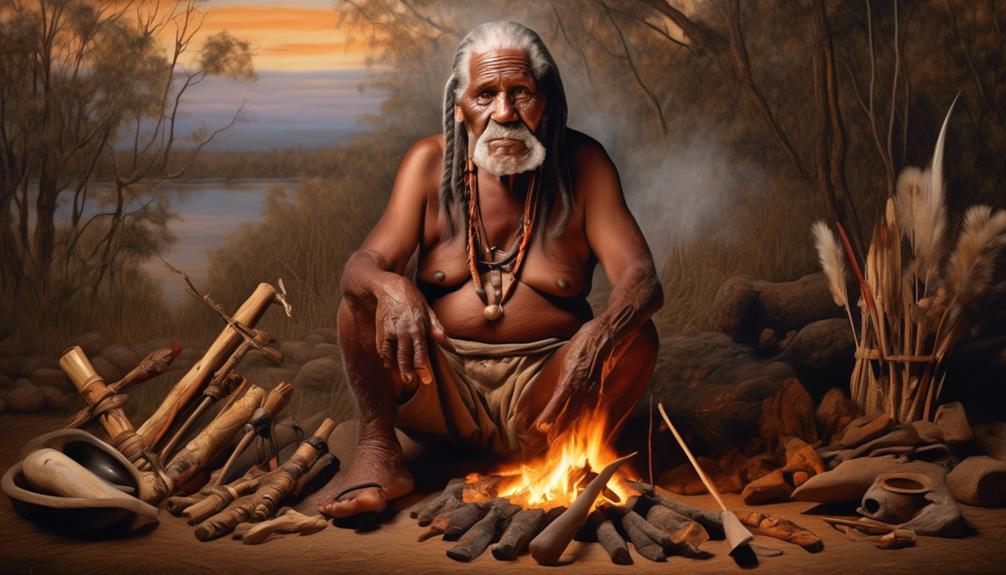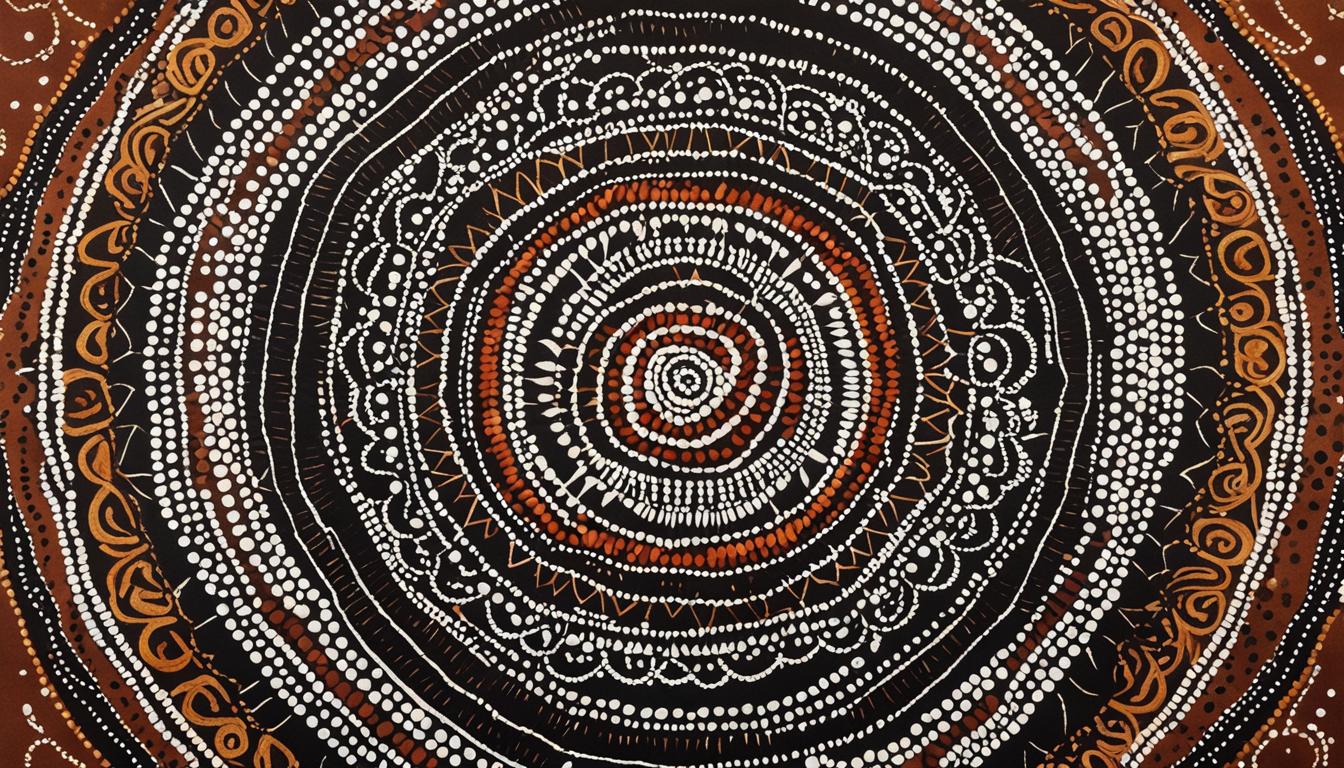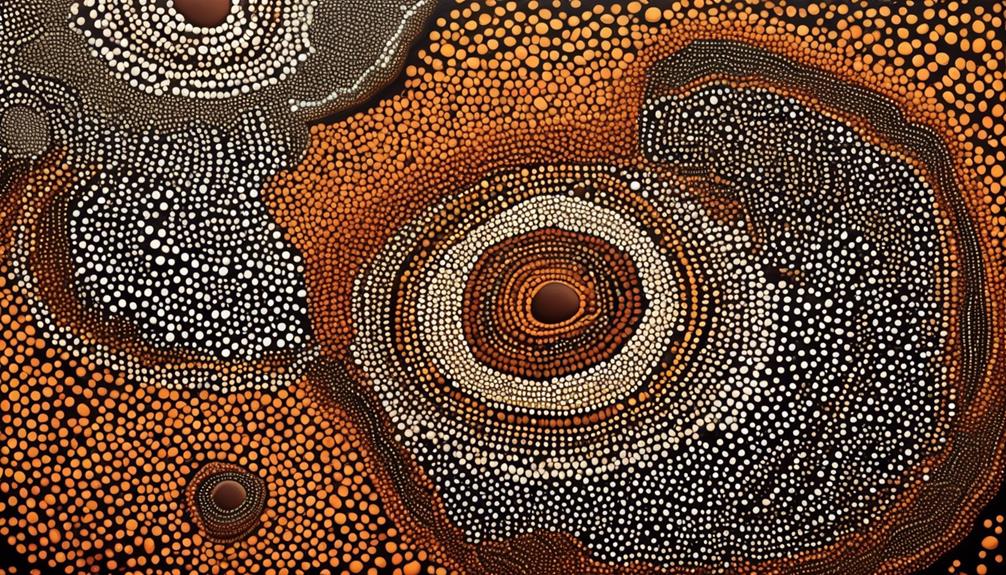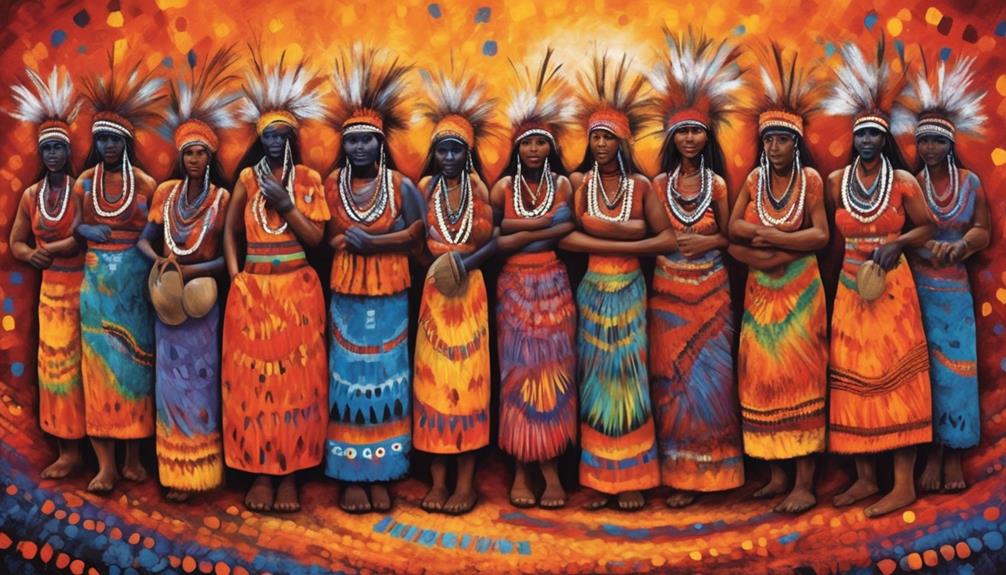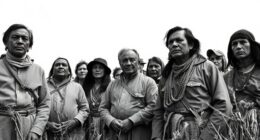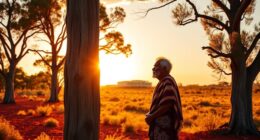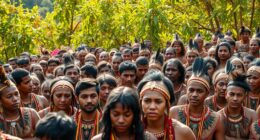Understanding the Aboriginal people is like peeling back the layers of a intricate tapestry. Each thread holds centuries worth of wisdom, resilience, and cultural richness. Their traditions and heritage hold a depth that is often ignored in mainstream narratives.
As we explore the multifaceted identities and experiences of the Aboriginal people, we begin to unravel a story that is both heartbreaking and inspiring. It's a journey that challenges our preconceptions and invites us to see the world through a different lens.
The Aboriginal people's story is steeped in tradition yet resilient in the face of adversity.
Key Takeaways
- Aboriginal people have one of the oldest continuous cultures in the world, with genetic ancestry studies showing a connection to the first modern humans who migrated out of Africa.
- Aboriginal traditions include ceremonies, storytelling, art, music, and dance, which mark important events and connect with ancestors and the spiritual realm.
- Aboriginal people have a deep interconnectedness with the land and inherit the responsibility of custodianship from their ancestors, guided by the principle of sustainable living.
- Over 250 distinct languages are spoken within Aboriginal communities, deeply intertwined with cultural practices, spiritual significance, and traditional knowledge. Efforts are underway to document and revitalize endangered languages.
Origins of Aboriginal People
The origins of Aboriginal people can be traced back thousands of years, revealing a rich and diverse history that's deeply intertwined with the land and environment. Genetic ancestry studies have provided valuable insights into the ancient lineage of Aboriginal people. These studies have shown that they're one of the oldest continuous cultures in the world, with genetic connections to the first modern humans who migrated out of Africa around 70,000 years ago. This deep ancestral connection to the land is a fundamental aspect of Aboriginal identity and culture.
Archaeological findings have also contributed to our understanding of the origins of Aboriginal people. These findings have unearthed evidence of their long and enduring connection to the Australian continent, with artifacts and rock art dating back tens of thousands of years. The archaeological record showcases the rich and complex cultural traditions that have been passed down through countless generations.
The genetic ancestry and archaeological findings collectively highlight the deep-rooted history of Aboriginal people, emphasizing their enduring presence and connection to the land. Understanding their origins is crucial in recognizing the significance of their cultural heritage and in fostering respect for their traditional knowledge and practices. It's a testament to the resilience and strength of the Aboriginal people, whose history and identity are deeply embedded in the ancient landscapes of Australia.
Ancient Cultural Traditions
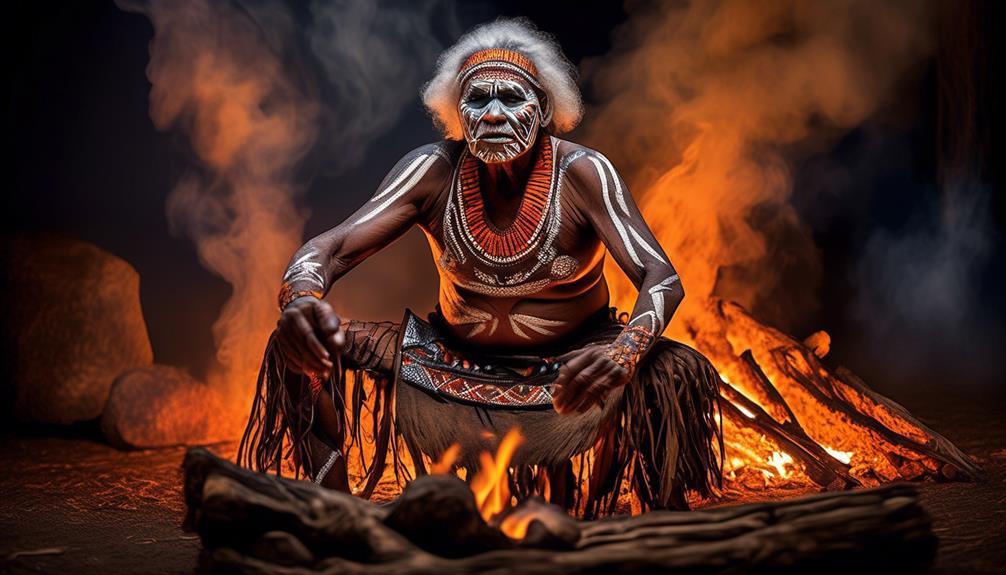
Exploring the enduring connection of Aboriginal people to the Australian continent, we uncover their ancient cultural traditions, which have been passed down through countless generations. Ancient rituals and traditional practices are integral to the Aboriginal way of life, reflecting a deep spiritual connection to the land and the natural environment. These traditions encompass a wide range of ceremonies, storytelling, art, music, and dance, each holding profound cultural significance.
Ancient rituals are often ceremonial in nature, marking important events such as initiation, marriage, and death. These rituals are deeply rooted in the belief systems of the various Aboriginal groups, serving as a means of connecting with ancestors and the spiritual realm. Traditional practices, including hunting methods, food gathering, and land management, demonstrate a sustainable and harmonious relationship with the environment that has been honed over thousands of years.
The preservation of ancient cultural traditions is vital to the identity and well-being of Aboriginal communities. These practices aren't simply historical relics but are actively maintained and adapted to contemporary contexts. They serve as a source of resilience and strength, providing a sense of belonging and continuity in the face of ongoing social and environmental challenges.
Understanding and respecting these ancient rituals and traditional practices is essential to appreciating the richness and diversity of Aboriginal cultures. It's an opportunity to recognize the profound wisdom and knowledge that have been carefully preserved and passed down through generations, enriching the cultural tapestry of Australia.
Land Connection and Custodianship
Deeply rooted in our cultural heritage, the aboriginal people maintain a profound connection to the land and assume the custodianship of its natural resources. This connection to land is fundamental to our identity and way of life. It encompasses not only the physical and practical aspects of sustaining ourselves but also holds immense cultural significance and is intertwined with our spiritual beliefs.
- Interconnectedness: Our connection to the land goes beyond the mere physical presence. It's a deep interconnectedness that's rooted in our history, traditions, and spirituality.
- Indigenous Custodianship: As indigenous peoples, we've inherited the responsibility of custodianship from our ancestors. This involves not only utilizing the land but also preserving and protecting it for future generations.
- Cultural Significance: The land isn't just a provider of resources; it's the canvas upon which our stories, customs, and traditions unfold. It's the foundation of our cultural identity.
- Spiritual Beliefs: Our spiritual beliefs are closely tied to the land. We believe that the land is imbued with spiritual energy and that it sustains not just our bodies but also our souls.
- Sustainable Living: Our custodianship of the land is guided by the principle of sustainable living. We seek harmony with nature, understanding that the land provides for us, and we, in turn, must care for it in a reciprocal relationship.
Diverse Aboriginal Languages
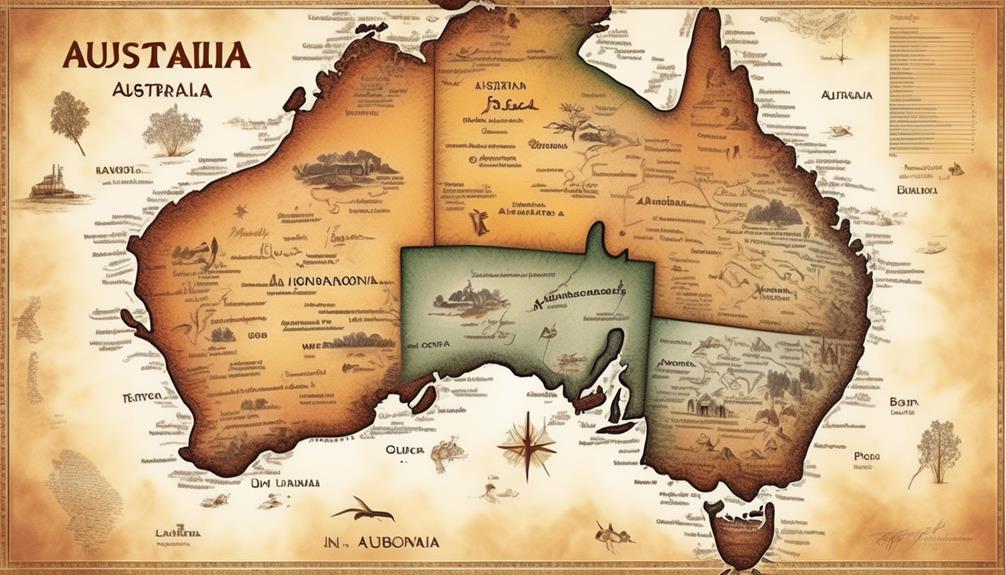
We'll explore the rich and diverse Aboriginal languages, each holding deep cultural significance.
The wide range of languages spoken by Aboriginal peoples reflects the rich tapestry of their heritage and traditions.
Understanding the importance of language diversity is essential in appreciating the depth of Aboriginal culture.
Language Diversity
Aboriginal communities across Australia speak a rich tapestry of diverse languages, reflecting the unique cultural and linguistic heritage of each group. This linguistic diversity is a vital part of our identity and plays a crucial role in language preservation and cultural revitalization.
Some key points to consider are:
- Over 250 distinct languages are spoken within Aboriginal communities, each with its own dialects and variations.
- Efforts are underway to document and revitalize endangered languages, ensuring their survival for future generations.
- Language programs and initiatives are actively promoting the use of traditional languages within communities and educational settings.
- Collaborative projects between linguists, communities, and educational institutions are aiding in the preservation and teaching of Aboriginal languages.
- The recognition of Indigenous languages in official capacities is an important step towards cultural inclusivity and respect.
Cultural Significance
Exploring the cultural significance of diverse Aboriginal languages reveals the profound impact of linguistic diversity on the preservation and revitalization of Indigenous heritage. Aboriginal languages are not merely a means of communication; they are deeply intertwined with cultural practices, spiritual significance, traditional knowledge, and ceremonial rituals. To illustrate the richness of this linguistic diversity, consider the following table:
| Language Group | Region | Cultural Practices |
|---|---|---|
| Yolngu | Northern Australia | Dreamtime stories, songlines |
| Anangu | Central Australia | Tjukurpa (ancestral law), ceremonies |
| Wiradjuri | New South Wales | Corroborees, art forms |
| Noongar | Western Australia | Bush tucker knowledge, dance |
These languages encapsulate the essence of Aboriginal cultural identity, serving as a conduit for passing down traditional knowledge and preserving ceremonial rituals.
Spiritual Beliefs and Practices
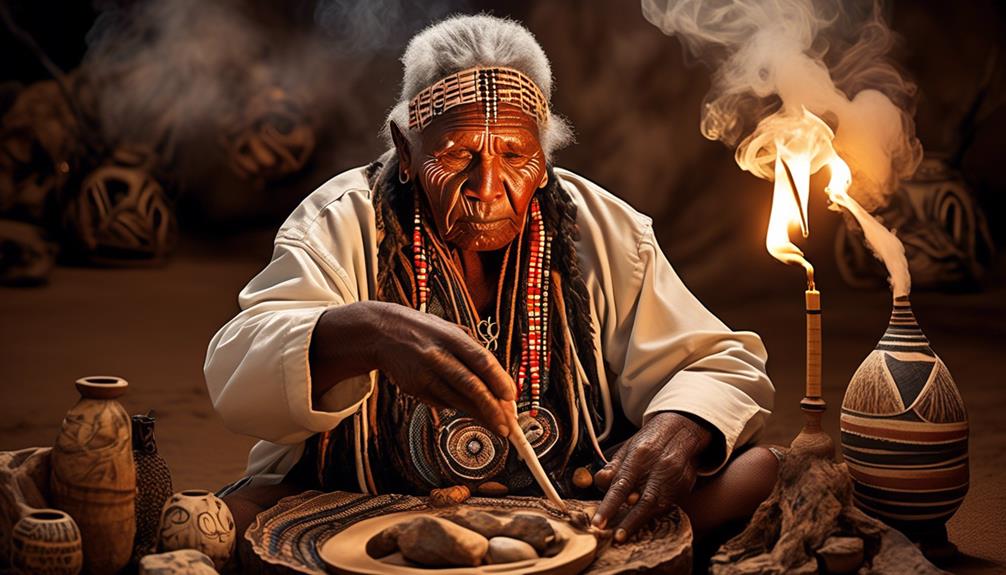
Engaging in a wide range of spiritual beliefs and practices, Aboriginal people maintain a deep connection to the land and the natural world. This connection is deeply rooted in our cultural heritage and shapes our understanding of the world around us.
Some of the key spiritual beliefs and practices include:
- Dreamtime stories: These stories are a significant part of our spiritual beliefs, describing the creation of the world and the spiritual ancestors who shaped the land. They're passed down through generations and are integral to our understanding of the world and our place within it.
- Rituals: Aboriginal people engage in various rituals that are deeply spiritual and often tied to the land and significant natural landmarks. These rituals are a way of connecting with the spiritual world and honoring our ancestors.
- Connection to nature: Our spiritual beliefs emphasize a profound connection to nature. The land, animals, and natural elements hold deep spiritual significance for Aboriginal people, and our spiritual practices often revolve around respecting and caring for the natural world.
- Ancestors: Ancestral spirits play a central role in our spiritual beliefs and practices. We believe that the spirits of our ancestors continue to guide and influence us, and we honor them through various rituals and ceremonies.
- Ceremonies: Ceremonial gatherings are an important part of our spiritual practices, providing opportunities for the community to come together, connect with the land, and engage in spiritual rituals that have been passed down through generations.
Impact of Colonization
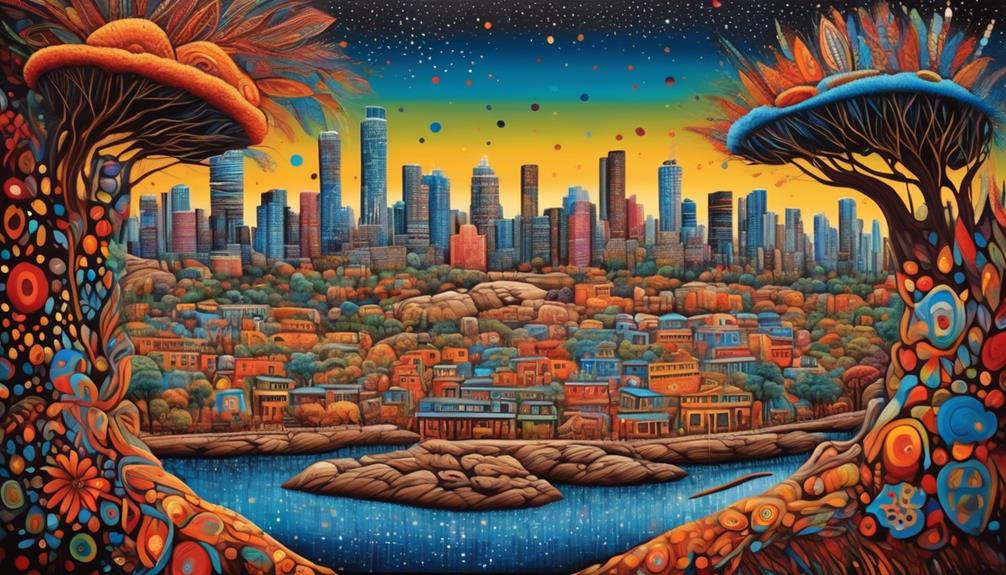
When European colonization began, Aboriginal people experienced significant loss of land and resources, impacting their traditional ways of life.
As a result of forced assimilation policies, many Aboriginal communities faced the erasure of their cultural practices, languages, and identities.
These historical impacts continue to shape the experiences and challenges faced by Aboriginal people today.
Loss of Land
The loss of land experienced by Aboriginal people due to colonization profoundly impacted their way of life and traditional connection to the land. This historical injustice continues to pose contemporary challenges.
The impact of land displacement on Aboriginal communities includes:
- Disruption of cultural practices and spirituality.
- Loss of traditional knowledge about land management and resource utilization.
- Impediments to economic self-sufficiency and food security.
- Undermining of community cohesion and social structure.
- Compromised access to sacred sites and areas of cultural significance.
Efforts to address these challenges and restore land rights are ongoing, aiming to support cultural preservation and the revitalization of Aboriginal connections to the land. Understanding the complexities of land loss and its enduring consequences is crucial for fostering meaningful reconciliation and supporting the rights of Aboriginal peoples.
Cultural Assimilation
The systemic loss of land experienced by Aboriginal people due to colonization not only disrupted traditional ways of life but also contributed to the forced assimilation of their cultural practices and beliefs. This cultural assimilation was a result of policies aimed at eradicating traditional Aboriginal practices and promoting cultural adaptation to the ways of the colonizers. Here's a table to illustrate some of the traditional practices that were impacted by cultural assimilation:
| Traditional Practice | Impact of Cultural Assimilation |
|---|---|
| Hunting and Gathering | Prohibited or restricted by colonial authorities |
| Spiritual Ceremonies | Suppressed and replaced with Christian practices |
| Language Use | Discouraged in favor of the colonizers' language |
The impact of cultural assimilation on Aboriginal people's traditional practices was profound, leading to the loss of cultural heritage and identity, and creating lasting challenges in preserving their unique way of life.
Stolen Generations and Reconciliation

Frequently, Aboriginal children were forcibly removed from their families and communities as part of government policies, resulting in the Stolen Generations, a dark chapter in Australian history seeking reconciliation. This systematic removal, which occurred from the late 1800s to the 1970s, aimed to assimilate Aboriginal and Torres Strait Islander children into Western culture, leading to the loss of language, culture, and identity. The impact of this traumatic experience is still felt today, with ongoing efforts to heal the deep wounds caused by these policies.
- Apology: In 2008, the Australian government issued a formal apology to the Stolen Generations, acknowledging the trauma and suffering inflicted upon them and their families.
- Redress: Various initiatives have been established to provide support and compensation to those affected, including the National Redress Scheme, offering acknowledgment, counselling, and a monetary payment to survivors.
- Reconciliation: Efforts towards reconciliation between Indigenous and non-Indigenous Australians continue, with a focus on understanding, empathy, and healing the historical injustices.
- Cultural Preservation: There's a growing emphasis on preserving and revitalizing Aboriginal and Torres Strait Islander cultures, languages, and traditions, recognizing their intrinsic value and importance for future generations.
- Indigenous Rights: Advocacy for Indigenous rights, self-determination, and empowerment remains a crucial aspect of the ongoing reconciliation process, striving to address systemic inequalities and uphold the rights of Indigenous peoples.
These steps are essential in fostering understanding, healing, and creating a more inclusive and equitable future for all Australians.
Contemporary Aboriginal Art
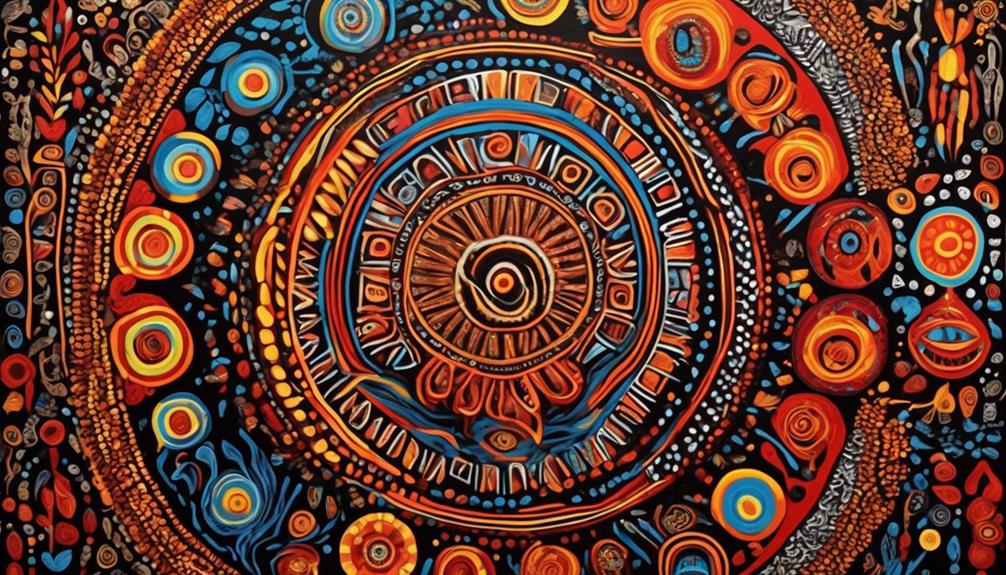
Contemporary Aboriginal art is a vibrant and important aspect of Indigenous culture, reflecting the richness and diversity of Aboriginal traditions and experiences.
It encompasses a wide range of artistic expressions, from traditional forms to innovative contemporary styles, and serves as a powerful medium for storytelling and cultural preservation.
As we explore the cultural significance in art and the modern influences and trends shaping contemporary Aboriginal art, we gain valuable insights into the ongoing resilience and creativity of Aboriginal communities.
Cultural Significance in Art
In contemporary Aboriginal art, the cultural significance is conveyed through diverse artistic expressions that reflect the deep connection to land, spirituality, and traditional stories. This art form serves as a powerful medium for cultural representation and preservation, allowing Aboriginal people to share their stories and traditions with the world. The significance of contemporary Aboriginal art lies in its ability to bridge the gap between the past and the present, serving as a visual reminder of the enduring strength and resilience of Aboriginal culture.
Some of the key features of contemporary Aboriginal art include:
- Vibrant use of colors and intricate patterns
- Depiction of Dreamtime stories and creation myths
- Exploration of connection to ancestral lands
- Expression of spiritual beliefs and symbolism
- Adaptation of traditional techniques to modern mediums.
Modern Influences and Trends
Modern influences and trends in contemporary Aboriginal art reflect the dynamic evolution of traditional artistic practices in response to global interactions and contemporary experiences.
Cultural adaptation has become a significant aspect of modern Aboriginal art, as artists explore new mediums, techniques, and styles while staying true to their cultural heritage.
The fusion of traditional elements with modern influences has led to the emergence of vibrant and innovative artworks that resonate with both Aboriginal and non-Aboriginal audiences. This adaptation has allowed Aboriginal art to thrive in the modern art world, gaining recognition and appreciation on a global scale.
Artists are also addressing current social and political issues, using their art as a platform for advocacy and cultural preservation. As a result, contemporary Aboriginal art continues to evolve, reflecting the ongoing resilience and creativity of Aboriginal peoples.
Aboriginal Contributions to Society

Aboriginal people have made significant and diverse contributions to society across various fields and disciplines. Their impact can be seen in art, music, science, literature, and more.
- Aboriginal Art: The unique and intricate art forms of Aboriginal people haven't only preserved their cultural heritage but also influenced contemporary art movements globally.
- Music: Traditional Aboriginal music and instruments have contributed to the rich tapestry of world music, and contemporary Aboriginal musicians continue to make waves in the music industry.
- Science and Medicine: Aboriginal knowledge of plants and natural remedies has contributed to modern pharmaceuticals and medical research, enriching the global understanding of traditional healing practices.
- Literature: Aboriginal storytelling traditions have influenced modern literature and provided valuable perspectives on history, culture, and the human experience.
- Environmental Stewardship: Aboriginal communities have long been at the forefront of environmental conservation and sustainable practices, offering valuable insights into living harmoniously with the natural world.
These contributions not only enrich the cultural fabric of society but also offer valuable insights and knowledge that benefit the wider world. It's important to recognize and celebrate the diverse and profound impact that Aboriginal people have had and continue to have on society.
Challenges and Resilience
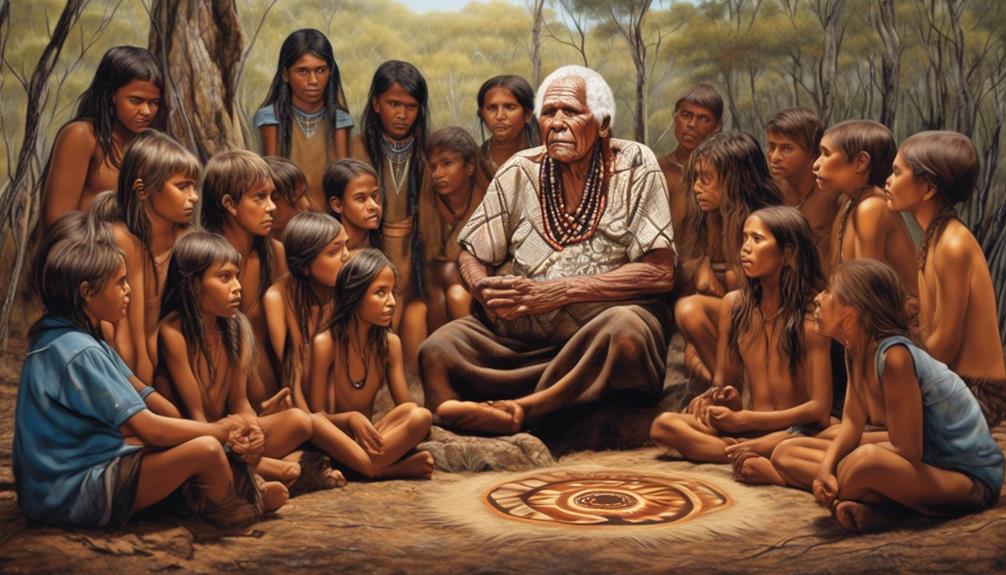
As Aboriginal people, we've faced historical oppression that has had a lasting impact on our communities.
Despite these challenges, we've shown remarkable resilience in preserving our cultural heritage and traditions.
Our ability to overcome adversity and maintain our cultural identity is a testament to the strength and determination of Aboriginal peoples.
Historical Oppression
Facing immense challenges, the Aboriginal people have displayed remarkable resilience in the wake of historical oppression. Despite enduring centuries of systemic discrimination and cultural erasure, they've persevered and maintained their unique cultural identity. The Aboriginal people's cultural resilience is evident in several ways:
- Preservation of traditional languages and customs, fostering a strong sense of community and heritage.
- Artistic expressions, such as storytelling, dance, and visual arts, serving as a means of cultural preservation and resistance.
- Advocacy for land rights and self-governance, asserting their sovereignty and connection to ancestral lands.
- Embracing education and knowledge sharing, empowering future generations to uphold their cultural legacy.
- Healing and reconciliation initiatives, striving to address the intergenerational trauma caused by historical oppression.
The Aboriginal people's resilience in the face of historical oppression serves as a testament to their strength and determination to preserve their cultural heritage.
Cultural Preservation
Despite enduring numerous challenges, the preservation of Aboriginal culture remains a testament to our resilience and determination.
Cultural preservation is a critical aspect of maintaining our identity and connection to our ancestral knowledge. Traditional practices, including storytelling, art, dance, and language, are pivotal in heritage conservation. These practices have been passed down through generations, embodying the essence of our cultural identity.
However, the ongoing impact of colonization, forced assimilation, and modernization poses significant challenges to preserving our cultural heritage. Despite these obstacles, Aboriginal communities continue to demonstrate remarkable resilience in upholding and revitalizing traditional practices. Through community-led initiatives, educational programs, and advocacy, we strive to ensure the preservation of our cultural legacy for future generations.
Our commitment to cultural preservation reflects our enduring strength and unwavering dedication to honoring our heritage.
Advocacy for Indigenous Rights
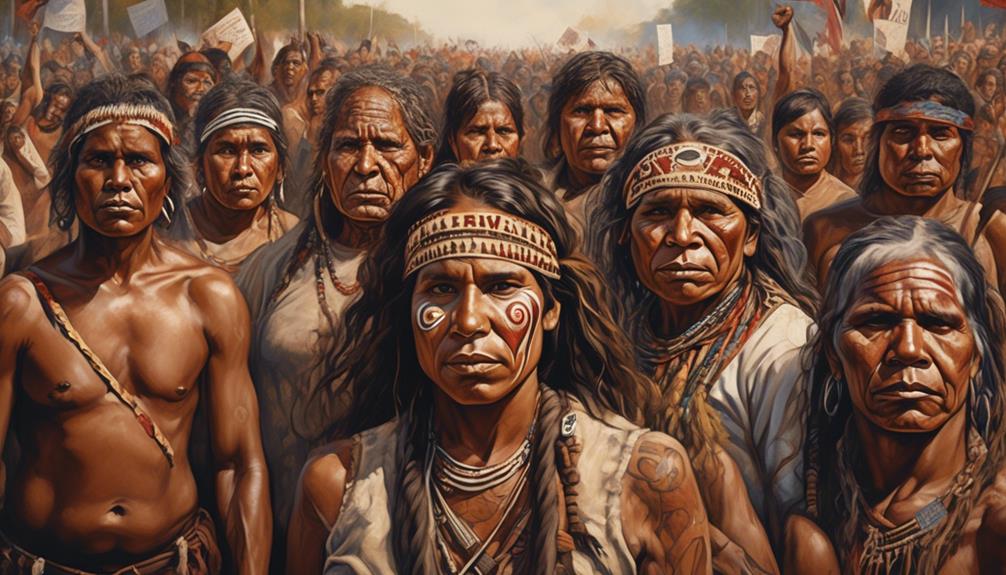
Advocating for Indigenous rights remains a critical endeavor in our society, exemplifying the ongoing struggle for equitable treatment and recognition of historical injustices. Indigenous activism plays a pivotal role in advocating for the rights of Indigenous peoples. It encompasses a range of activities, such as organizing rallies, lobbying for policy changes, and engaging in legal battles to protect their rights.
Cultural revival is an essential aspect of advocating for Indigenous rights, as it seeks to reclaim and celebrate traditional practices and knowledge that have been historically marginalized.
- Legal Protection: Indigenous rights advocates work towards securing legal protection for Indigenous lands, resources, and cultural heritage.
- Education and Awareness: They strive to educate the public about the historical and ongoing injustices faced by Indigenous communities, fostering greater awareness and empathy.
- Political Representation: Advocates push for increased representation of Indigenous voices in political decision-making processes, aiming to address systemic inequalities.
- Socioeconomic Empowerment: Efforts are made to improve the socioeconomic conditions of Indigenous communities, including access to healthcare, education, and economic opportunities.
- Cultural Preservation: Advocates emphasize the importance of preserving and promoting Indigenous languages, customs, and traditions, recognizing them as integral to Indigenous identity and well-being.
Advocacy for Indigenous rights is an ongoing and multifaceted pursuit, essential for fostering a more inclusive and just society. It requires collaborative efforts from various stakeholders to address the complex challenges faced by Indigenous peoples.
Aboriginal Land Rights
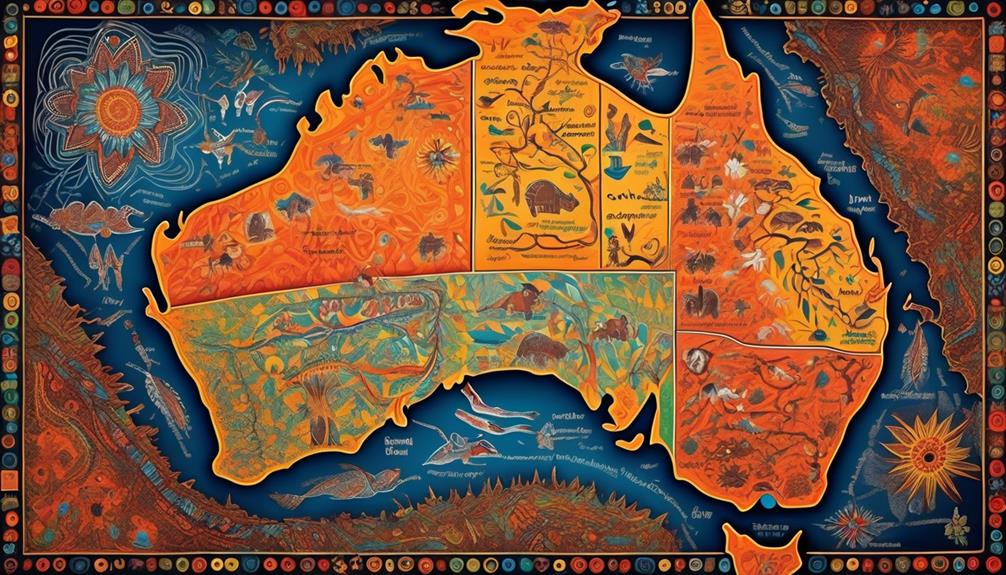
Aboriginal land rights are deeply intertwined with the historical and ongoing struggle for recognition and preservation of Indigenous territories and resources. These rights are rooted in the concept of aboriginal land ownership, which acknowledges the inherent connection of Indigenous peoples to their traditional lands. The struggle for these rights embodies the broader fight for indigenous sovereignty, encompassing not only the physical land but also the cultural and spiritual significance it holds for Aboriginal communities.
The quest for Aboriginal land rights has been marked by significant milestones, including legal battles, activism, and political negotiations. These efforts have led to the establishment of various mechanisms aimed at recognizing and protecting Indigenous land rights, such as native title legislation and land rights acts. Despite these advancements, challenges persist, particularly concerning the extent of land recognition and the enforcement of these rights.
Indigenous sovereignty is intricately linked to the preservation of cultural heritage and environmental conservation. Aboriginal land ownership isn't just about legal title; it encompasses the responsibility to care for the land and maintain the cultural practices and traditions associated with it. The struggle for Aboriginal land rights is a multifaceted endeavor that goes beyond legal frameworks, embodying the resilience and determination of Indigenous communities to safeguard their territories and resources for future generations.
Celebrating Aboriginal Heritage
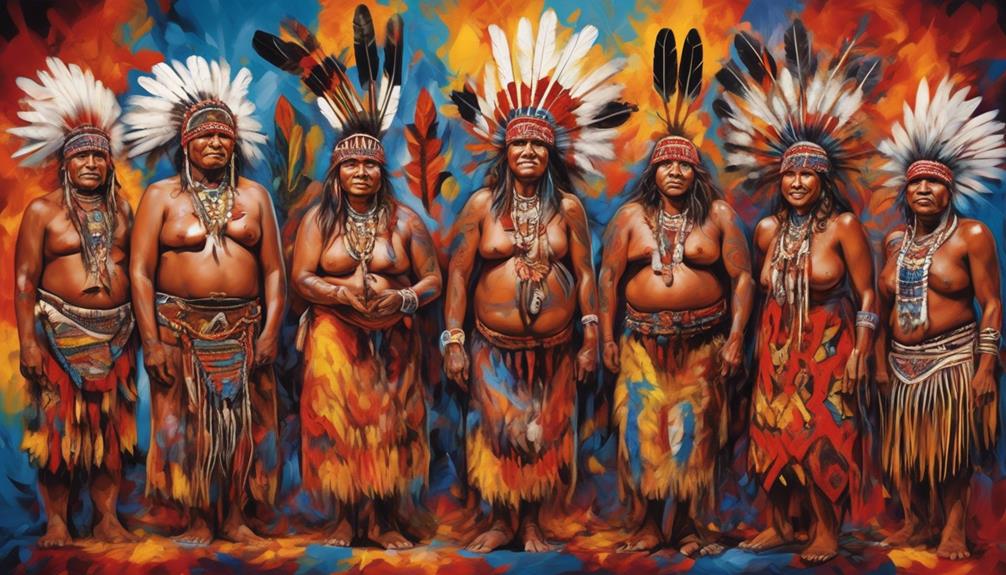
The preservation of Aboriginal land rights and the recognition of Indigenous sovereignty are integral to celebrating the rich and diverse heritage of Aboriginal people. Celebrating tradition and cultural resilience is essential to honor the history and ongoing contributions of Aboriginal communities. Through various forms of expression, the celebration of Aboriginal heritage serves to foster understanding and respect for the unique customs and traditions of Indigenous peoples. This celebration also highlights the resilience and strength of Aboriginal cultures in the face of historical and ongoing challenges.
- Cultural Festivals: Aboriginal communities host cultural festivals that showcase traditional dances, music, art, and storytelling, providing an opportunity for people to engage with and learn about Aboriginal culture.
- Art and Craft Exhibitions: Aboriginal artists often use their work to celebrate their heritage and share their stories, with exhibitions serving as platforms to display and promote Indigenous art and craftmanship.
- Cultural Workshops: These workshops offer hands-on experiences, allowing participants to learn traditional practices such as weaving, bush tucker foraging, and traditional tool making, preserving and passing down Aboriginal knowledge.
- Language Revitalization Efforts: Initiatives aimed at reviving and preserving Aboriginal languages contribute to the celebration of cultural heritage, emphasizing the importance of linguistic diversity.
- Cultural Education Programs: Schools and community organizations offer programs to educate the broader public about Aboriginal traditions, fostering greater understanding and appreciation for Indigenous cultures.
Embracing Aboriginal Perspectives
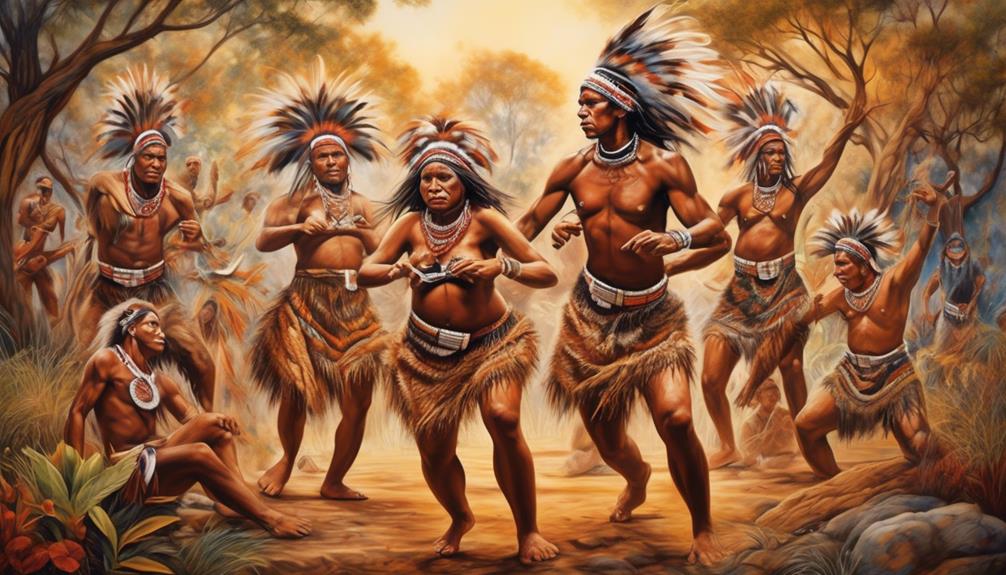
What are some ways to incorporate Aboriginal perspectives into contemporary society?
Embracing Aboriginal perspectives involves actively engaging with and respecting traditional knowledge sharing and aboriginal storytelling. One way to achieve this is by recognizing and promoting the value of oral storytelling as a means of passing down cultural knowledge from one generation to the next. By incorporating aboriginal storytelling into educational curricula and public events, contemporary society can gain a deeper understanding of Aboriginal culture and history.
Furthermore, embracing Aboriginal perspectives involves acknowledging the importance of traditional knowledge sharing in various aspects of life. This can be done by actively seeking opportunities to learn from Aboriginal elders and knowledge keepers, who hold valuable insights into sustainable living, land stewardship, and holistic well-being. By integrating traditional knowledge into fields such as environmental conservation, healthcare, and community development, contemporary society can benefit from the wisdom and expertise of Aboriginal peoples.
In addition, embracing Aboriginal perspectives requires actively working to dismantle stereotypes and misconceptions that may exist within contemporary society. This involves promoting accurate and diverse representations of Aboriginal peoples in media, literature, and the arts, as well as creating platforms for Aboriginal voices to be heard and valued.
Ultimately, embracing Aboriginal perspectives is a continual process of learning, unlearning, and respecting the rich cultural heritage and contributions of Aboriginal peoples to contemporary society.
Frequently Asked Questions
How Do Aboriginal People Feel About Modern Technology and Its Impact on Their Traditional Way of Life?
We, as Aboriginal people, have complex feelings about modern technology's impact on our traditional way of life. While some of us embrace the opportunities it brings, others are concerned about the impact of globalization on our cultural preservation.
It's a delicate balance, as we strive to maintain our traditions and values while also benefiting from the advancements that technology offers.
Our perspectives on this issue vary, reflecting the diversity within our communities.
What Are Some Common Misconceptions About Aboriginal Spiritual Beliefs and Practices?
Misunderstood beliefs about Aboriginal spiritual practices often stem from lack of understanding and cultural preservation. It's important to recognize that these beliefs are deeply rooted in tradition and have been passed down for generations.
Misconceptions can arise from limited exposure to accurate information. By respecting and learning about these practices, we can help dispel misconceptions and support the preservation of Aboriginal culture.
How Have Aboriginal Languages Influenced the Development of Other Languages in Australia?
Aboriginal languages have had a profound impact on the evolution of other languages in Australia. The linguistic influence has sparked cultural exchange and societal integration, shaping the development of Australian languages.
The intricate nature of these languages has contributed to a rich tapestry of linguistic diversity, influencing not just words and phrases, but also the way in which languages are structured and communicated.
This influence has left an indelible mark on the linguistic landscape of Australia.
What Are Some Ways That Non-Indigenous People Can Support the Advocacy for Indigenous Rights?
Supporting advocacy for indigenous rights can involve:
- Amplifying indigenous voices
- Educating oneself on indigenous issues
- Advocating for policy changes
Additionally, promoting cultural preservation through:
- Supporting indigenous art
- Language revitalization
- Land rights
is crucial. Engaging in respectful dialogue and actively listening to indigenous leaders' perspectives is essential in this process. It's important to recognize the diversity within indigenous communities and support their autonomy in advocating for their rights.
What Are Some Examples of Contemporary Aboriginal Art That Have Gained International Recognition?
Contemporary Aboriginal artists like Emily Kame Kngwarreye and John Mawurndjul have gained international recognition for their powerful and innovative work. Their art reflects the rich cultural traditions and stories of Indigenous Australians while also exploring modern themes and techniques.
Their success on the global stage has helped to bring attention to the diverse and vibrant contemporary Aboriginal art scene, showcasing the talent and creativity of Indigenous artists to the world.
Conclusion
As we journey through the rich tapestry of Aboriginal culture, we're reminded of the deep roots and enduring spirit of the First Nations people.
Their ancient traditions, diverse languages, and spiritual beliefs are like a vibrant mosaic, reflecting the beauty and resilience of their heritage.
Let's continue to honor and embrace Aboriginal perspectives, standing in solidarity with their advocacy for indigenous rights and celebrating their custodianship of the land.
